Yes, it's time to catch some femtoamps

.
In this thread we will teardown
Keysight Technologies B2980A series instrument which include four models, from basic high-performance picoammeters (B2981A and B2983A) to fully featured electrometer equipped with integrated high-voltage source and high-impledance voltage input (B2985A and B2987A).

In this article we will take a look on top SKU - Model B2987A Electrometer/High-resistance meter.
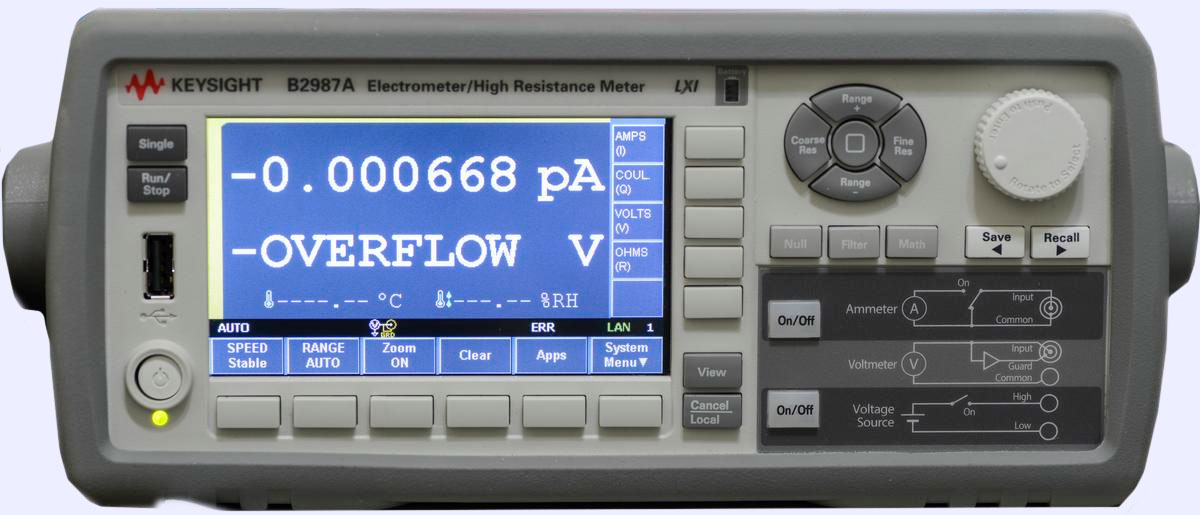
To understand why high impedance of the voltmeter can be important, we can try to compare portable DMM and high-end DMM with electrometer, in role of the voltage measurement device. As a device under test we pick some high-impedance output source, such as light sensor or humidity sensor. For sake of this mind experiment we picked Zsource = 100 MOhm.

Values above are NOT complete accuracy specifications and not include all error contributors of the measurement setup, but give the basic idea how DUT loading with meters own input impedance can affect the measurement results.
Manuals referencesTo our misfortune there are no service or calibration manuals available for any of the B2980A series instruments.
B2980A series datasheetB2980A User’s Guide, Edition 4, March 2016B2980A Programming Guide, Edition 2, March 2016B2980A SCPI Command Reference, Edition 3, March 2016B2980A Configuration guideB2980A Product Fact SheetAN: Reliable High-Resistance Measurements Using the B2985A/87AAN: Low Current Semiconductor Measurements Using the B2980A Series AmmeterAN: Measuring Insulating Material Resistivity Using the B2985A/87A and N1424N1414A High Resistance Measurement Universal Adapter briefN1420A Setup Integrity Checker Function briefIon Beam Current Measurement - Product Fact SheetAN: Wide Range of Resistance Measurement Solutions from μOhm to POhmAN: Capacitance Leakage Current Measurement Techniques Using the B2985A/87AAN: Real-time Noise Monitor Function in B2980AN1424, N1425, N1427, N1428 Accessories for Keysight B2985A/B2987AExteriorInstrument designed around common half-rack format, with large display and programmable front panel buttons. All inputs and connection ports are located on the instrument rear side. Optional battery is installed in the special bay located on the top side. Front and rear plastic bezel frame are protected from damage by rather massive rubber boots. Boots and adjustable handle can be easily removed for rackmount installation.
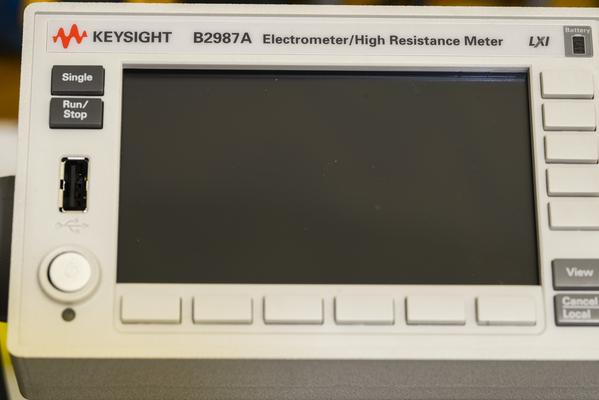
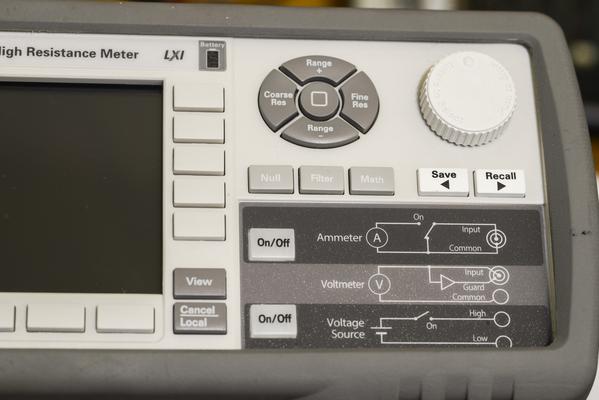
This electrometer is 100% silent, as it does not contain any fans. Fans generate vibration which can cause big problem for sensitive instrument like this. Vibration would translate into electrical noise by the triboelectric effects in cables and piezoelectric effects in ceramic-based components like surface-mount capacitors. The triboelectric charge is generated when friction stress applied to both cable conductor and insulator, resulting in charge stored on the insulator surface. This effect can be seen when vibration coupled into cable, and as a result, it is likely that there are many risks to suffer from this noise. Any cable on test setup and interconnect can act as the noise source due to triboelectrics.
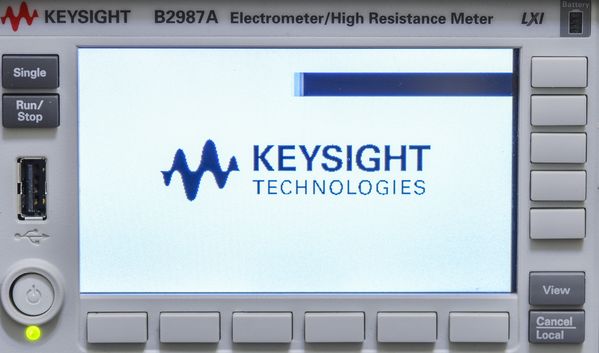
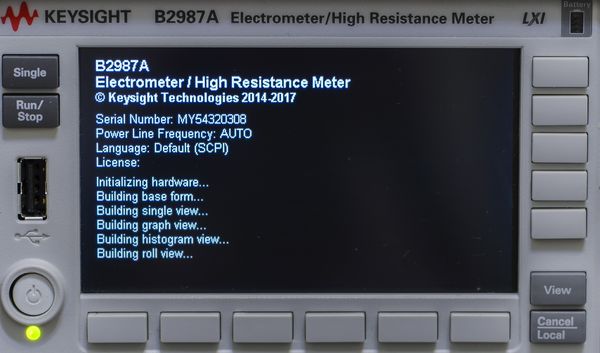
Since this meter runs some sort of RTOS(Real-time Operation System), it takes about 53 seconds to boot up before it's ready for operation. It's not important for typical workflow, as you need few hours warm-up time to reach specified accuracy but some engineers do like faster boot-up time for some reason. Front panel sports full-color TFT panel without touchscreen, falling for modern trend with large LCD on everything, rather than expensive and fragile high-contrast VFD displays. Of course both display types have strong and weak spots, but contrast and visibility angles of the VFDs are not possible to beat with TFT panel. OLED provides great contrast too, but many of them fall by low life period. It is not uncommon for expensive test equipment to be in use for decades without powering off, so display life is one of the parameters to consider.
Also fonts used on display... Our apologies to Keysight engineers, but meter have
at least five different fonts used in UI as they were not sure which one looks better. Why, Keysight?
Courier New font in my opinion not the best font for relatively small LCD display either. Modern Keithley LCD GUI design in that respect much more pleasing, even though overall colorful TFT LCD displays in professional instruments more of a gimmick, than necessary functionality. Also LCD do always come out ugly on photographs, just a reviewer note.
Overall UI performance is rather underwhelming, it does not take lot of time to notice lags and lot of interface quirks during standard operation from front panel. Yes, yes, this instrument supposed to be put in the rack, connected over GPIB/LXI and never seen again, but it's fair to expect wee bit more effort put into $11000 instrument..
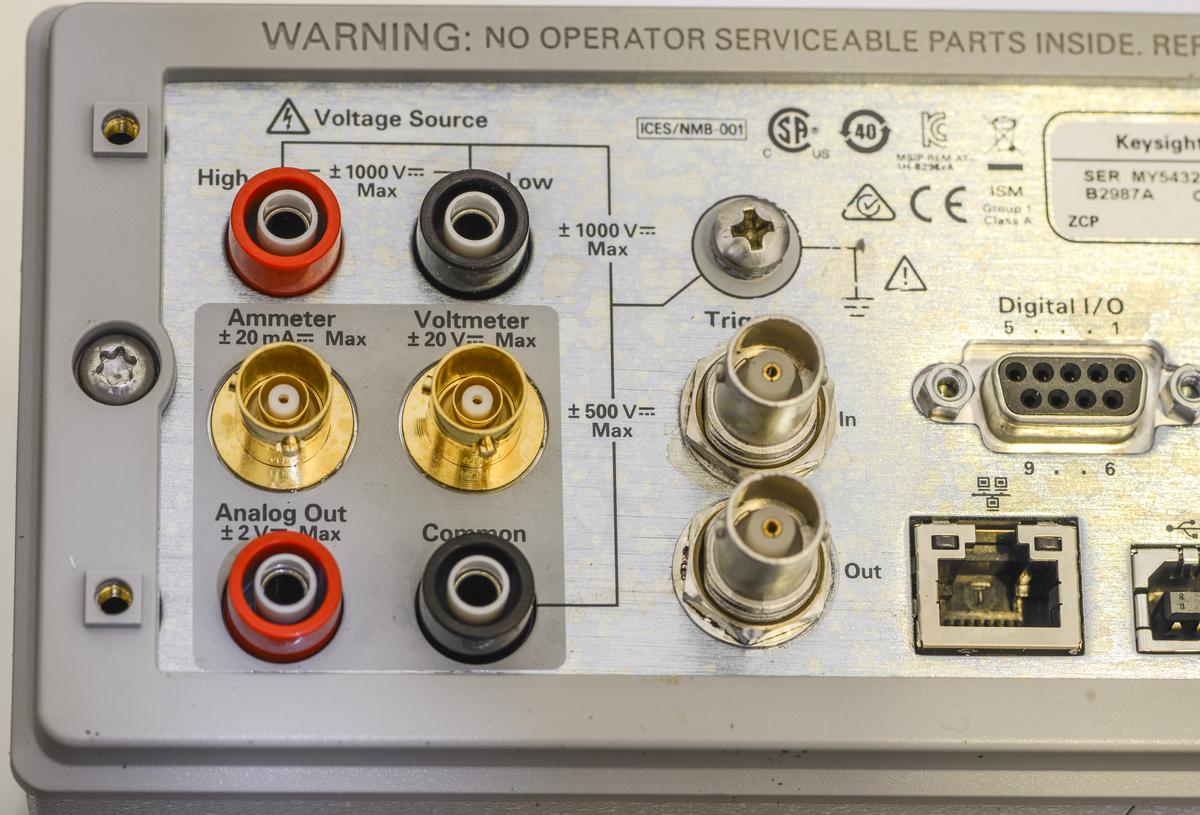
Rear panel have lot of various interfaces and connectors:
* Voltage source HI/LO shrouded 4mm banana ports
* Analog output HI/LO shrouded 4mm banana ports
* Ammeter gold-plated 3-lug triaxial input (2 pA to 20 mA ranges)
* Voltmeter gold-plated 3-lug triaxial input (2 and 20V ranges)
* GPIB remote control port
* USB Device remote control port
* LAN remote control port with LXI support
* Trigger In and Out BNC ports for precise timing
* Digital I/O to interface DUT fixtures
* Interlock input for DUT fixture, to safely limit voltage source below 21V during DUT replacements
* Humidity digital interface port, designed to support E+E EE07 probe
* Type-K miniature thermocouple input with CJC(Cold Junction Compensation) sense
* Common point for chassis connection
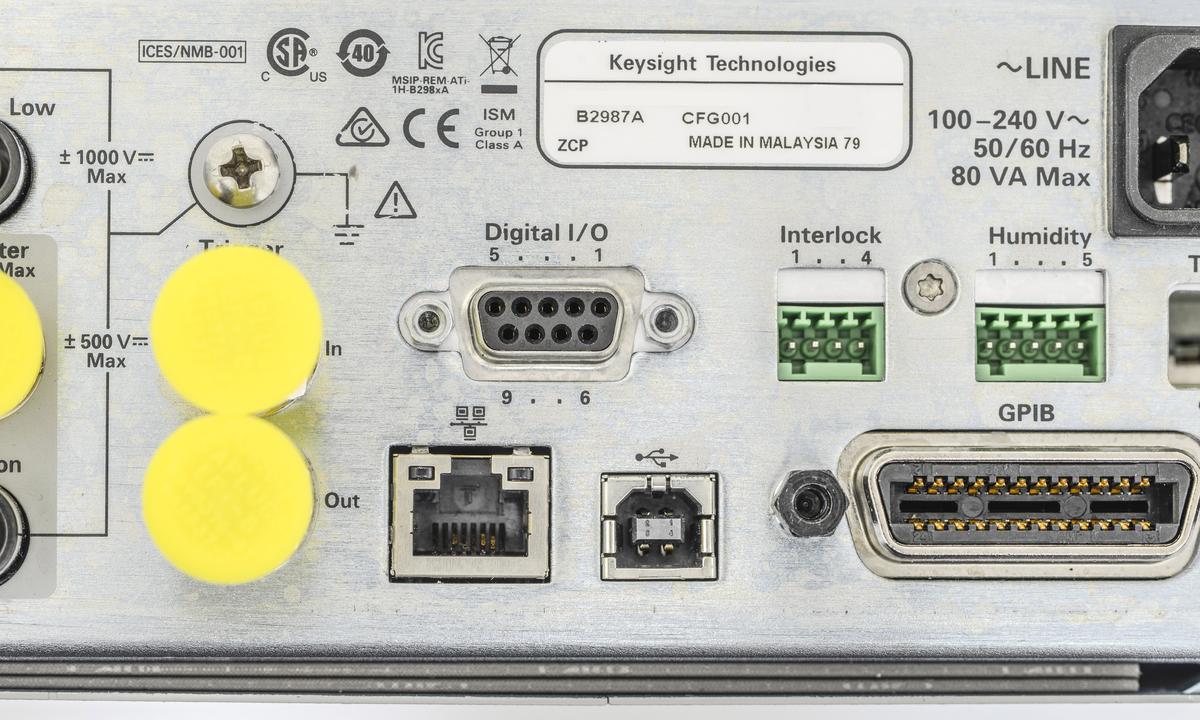
Those triaxial inputs look so pretty with surface gold plating. We also see trigger BNC ports to allow syncronisation of the meter with another experiment equipment for precise timing. Also glad to see GPIB is still present on this modern instruments to allow easy integration within older instrumentation.
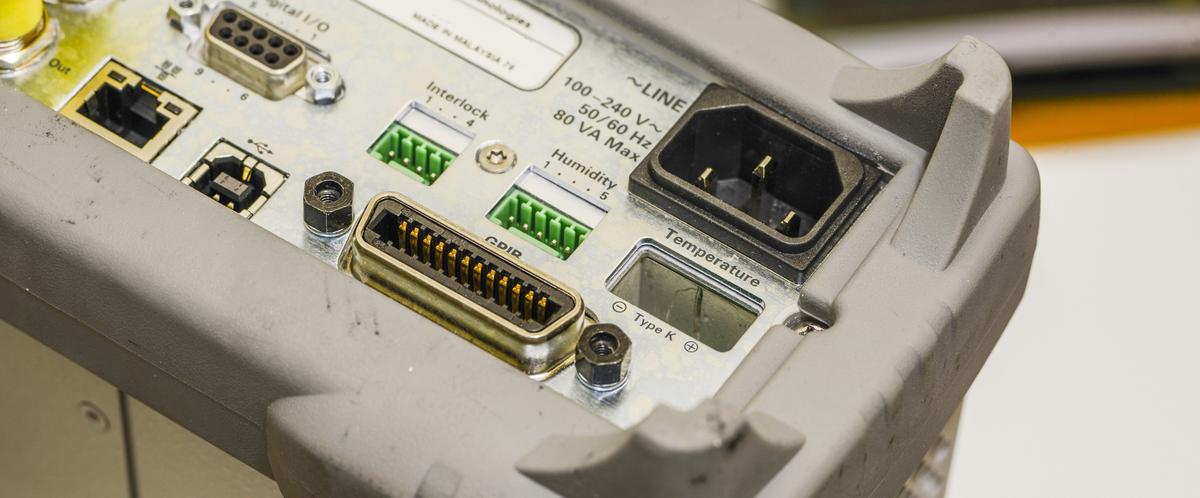
Use for triaxial inputs is essential for sensitive instrument like this to prevent leakages of the current between input signal terminal and outer shield/common return. We will cover more on this topic further in the article during the circuit design review. Operation of both current meter and voltage source is decoupled by own ON/OFF buttons to allow flexible operation and easy zero offset corrections.
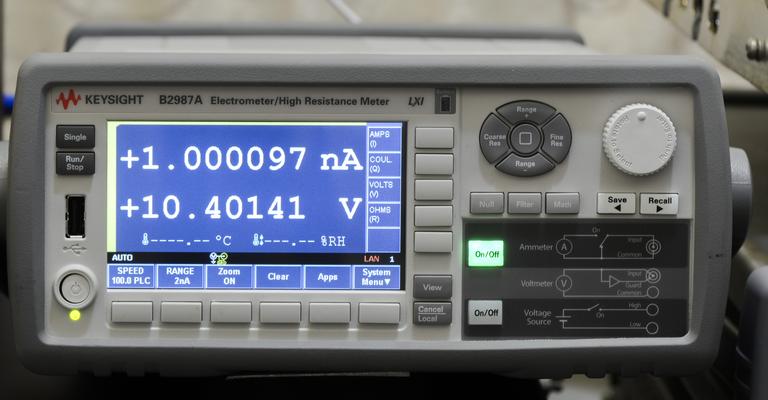 Design and internal design review
Design and internal design review -1200 and +1200VDC voltages present inside of this electrometer when operation are dangerous and even lethal. Pay attention of what you are doing, and keep all connections nice and tidy. Use hands-free probing technique to ensure safety. Use tools rated for CAT III operation while servicing high-voltage live circuits in this instrument.
-1200 and +1200VDC voltages present inside of this electrometer when operation are dangerous and even lethal. Pay attention of what you are doing, and keep all connections nice and tidy. Use hands-free probing technique to ensure safety. Use tools rated for CAT III operation while servicing high-voltage live circuits in this instrument.After removing rear bezel and metal cover with help of typical HP size Torx screwdriver internal boards are available for access. Top side reveals high-voltage output assembly, mains AC-DC switching power supply brick, battery charger PCBA and various interconnects. This is modern instrument, so majority of the components are mounted by SMT, as expected. Everything inside is organized and tidy, as you would expect from $11K professional instrument.
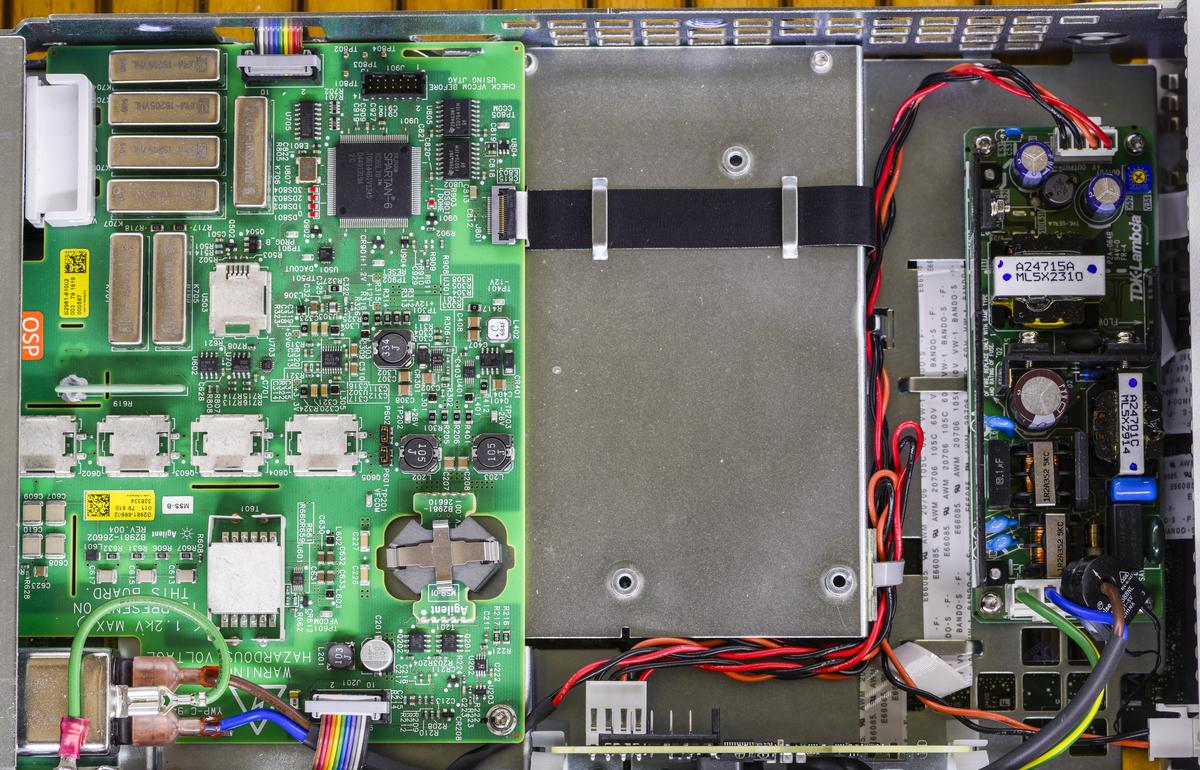
Cable harness carefully fixed to the chassis parts, so no loose wires running around. Top board in the back of the unit is high-voltage output source. B2981A and B2983A units will not have this board present.
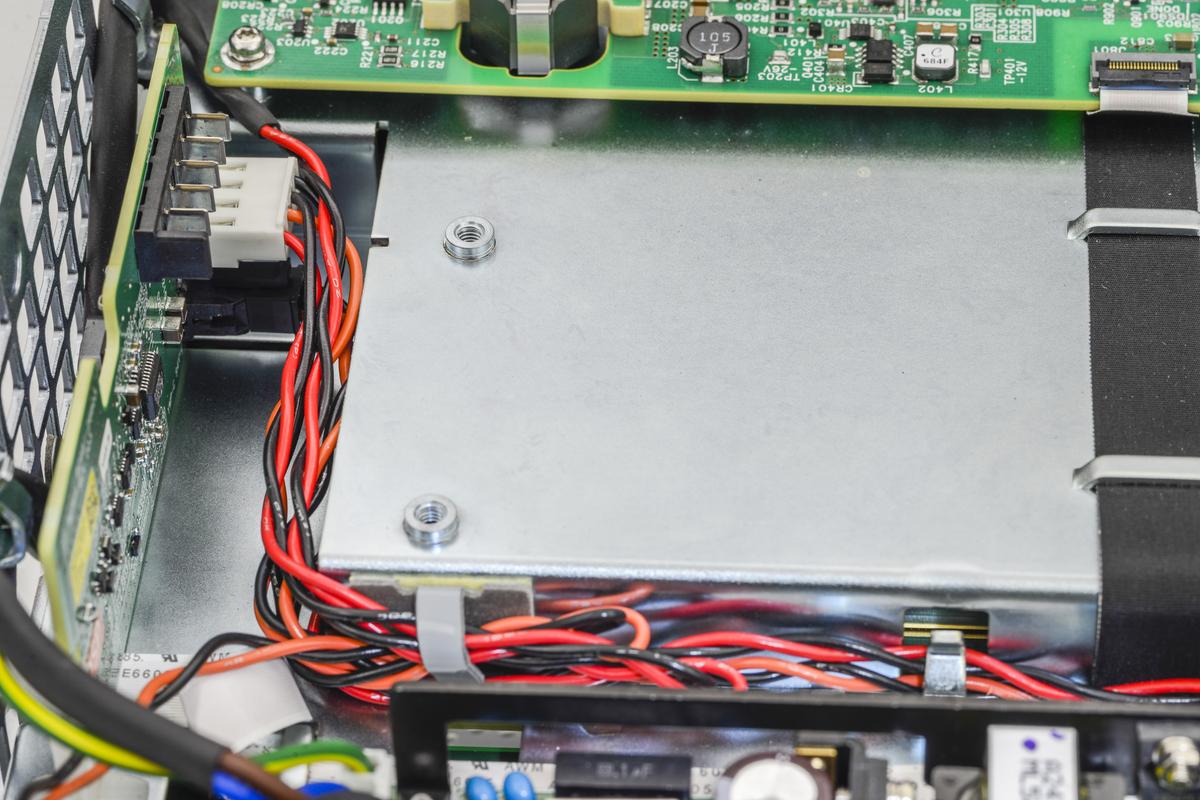
Bottom side reveals back side of main acquisition board, small digital brain SOC module and multiple interconnect flat ribbon cables.
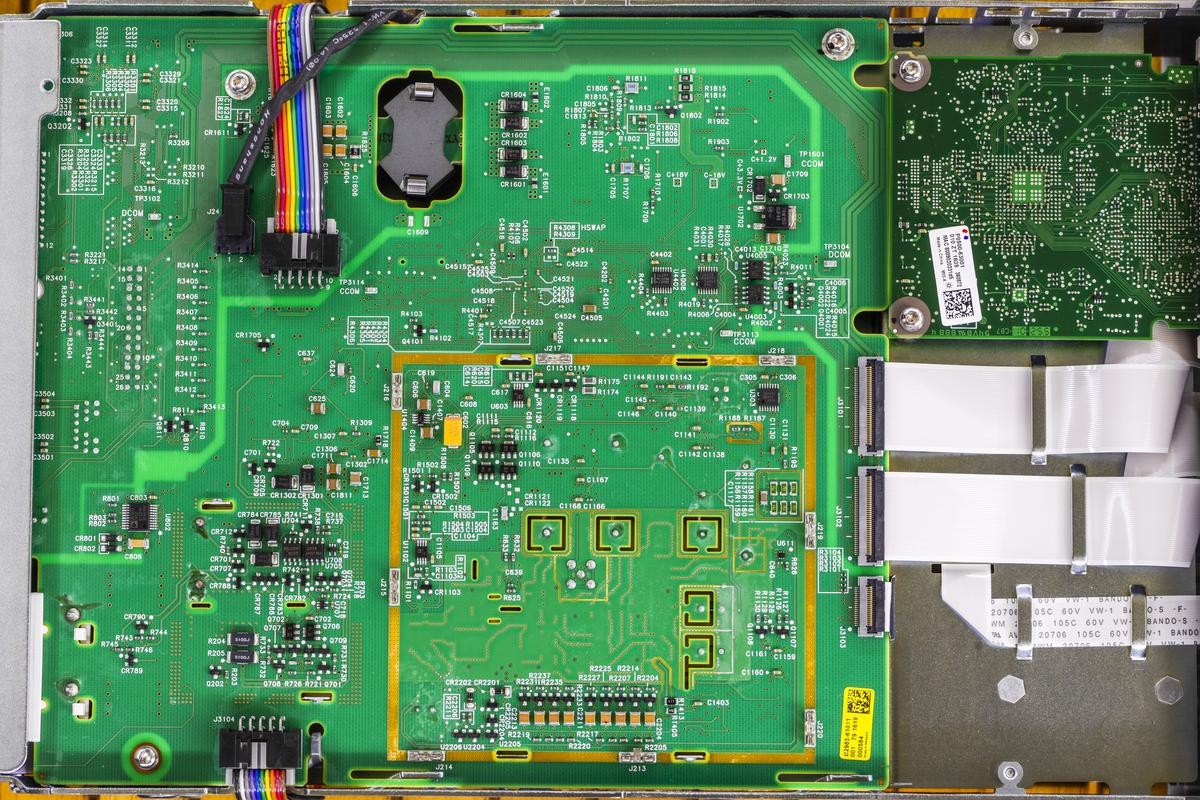
Analog board have fully shielded areas, enclused from both sides, but Image above have shield removed for clarity. Electrometer input circuitry is extremely sensitive and must be kept clean to maintain instrument's performance, so use of proper gloves to prevent board contamination is mandatory here.
Mains AC-DC power supplyInput power supply is high-quality switching module is 50W 24VDC output, made by TDK-Lambda, model
ZWS50BAF-24. It retails for $80 USD, and provides output current up to 2.1A from the universal input 85-264 VAC mains. Output noise and ripple maximum specification is 150 mV pk-pk so it is not low noise supply. It's not a problem as this PSU output will be regulated and isolated from any sensitive circuitry by onboard POL(point-of-load) regulators on main boards.
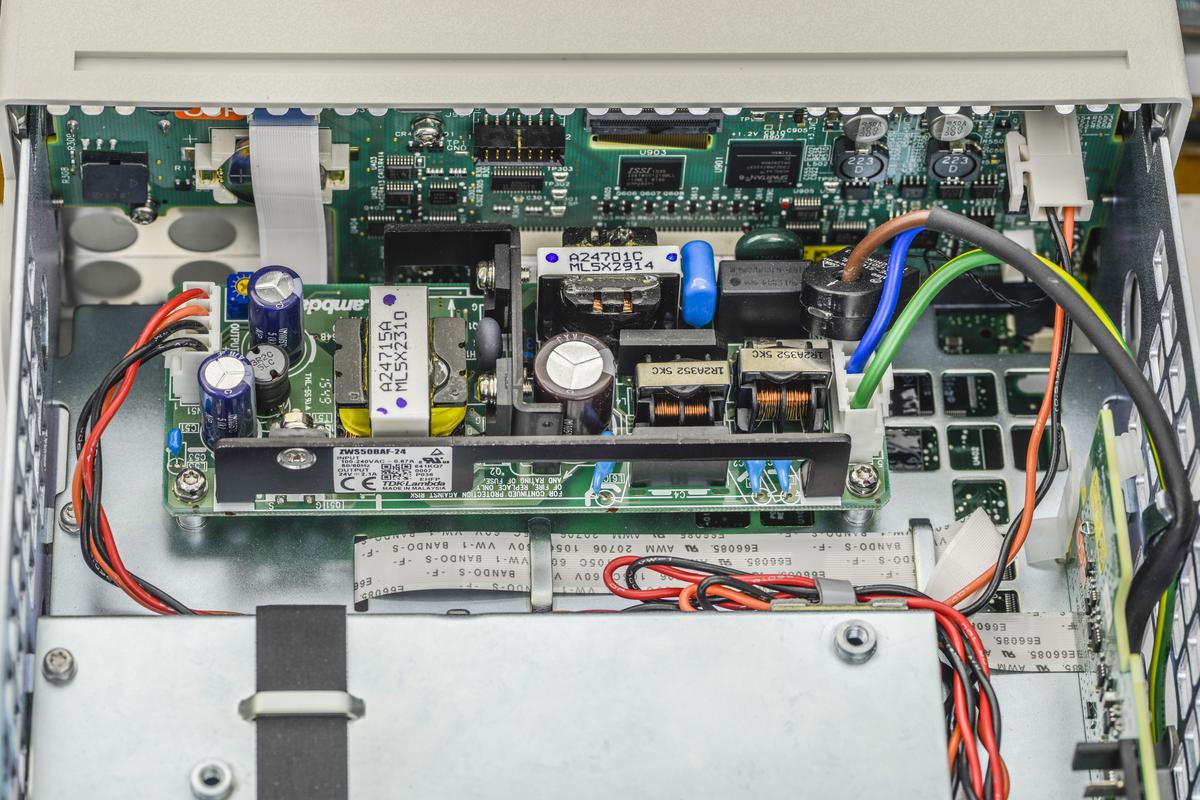
Also front panel board is visible behind the power supply. We will not be taking that part off, as there is nothing interesting on the front panel. Just Xilinx Spartan 6 FPGA with DRAM chip to handle color TFT interfacing and GUI refresh, keyboard readout and related DC-DC power for digital domain of the instrument. Most likely this front panel board reuse design from other instruments in series as well.
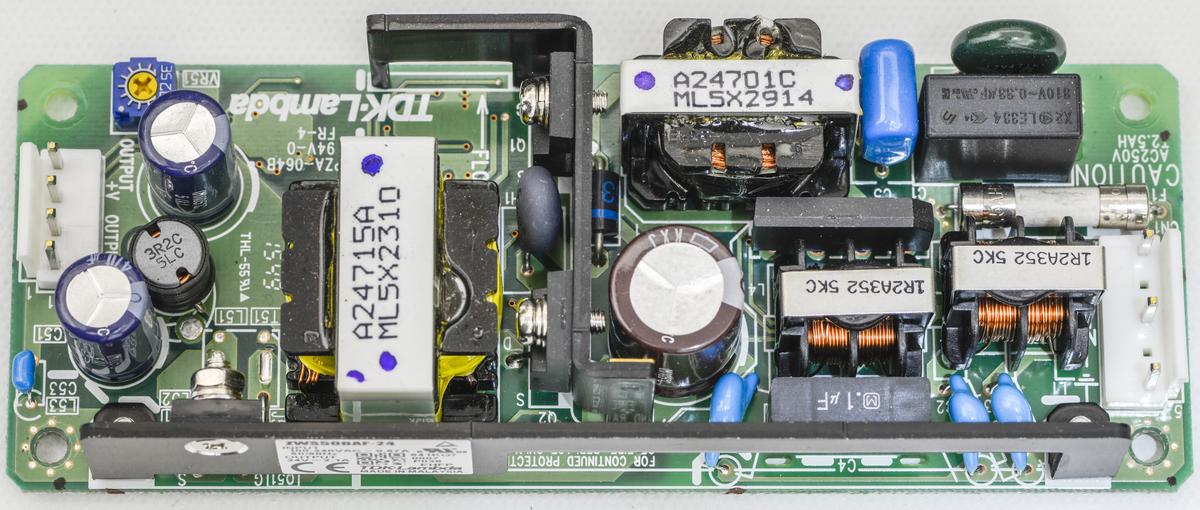
Back to power supply module, mains input arrive to the instrument from the right side connector, pass onboard line fuse, go thru passive CMC and protection components, rectified to high voltage DC by a bridge and storage capacitors and then AC/AC controller and power FET provide drive to a switching pulse transformer. AC/DC module have top tier Chemicon KXJ +105 °C rated capacitor on primary side and pair of Chemicon LXZ low-ESR +105 °C capacitors on the output side. No cheap capacitors of unknown original, nothing to complain about here.

There is little adjustable trim-pot resistor near the output connector. Perhaps it's available to adjust output voltage, if needed.

Power supply module was manufactured in Malaysia around week 49, year 2015. Bottom side is packed with SMT components, there is room even for one tiny SOT-363 device. Most of surface mount passives are 1206 and 0603 size. Two optocouplers provide feedback signal to the high side for output regulation and protection.
Interesting detail visible on the mains cable to the power supply. Line wire before entering PSU have small current transformer, with secondary connected to front panel PCBA. Perhaps this is used to detect the mains grid frequency for automatic PLC timing setting? I see no obvious reason why meter would possible need measurement of it's own input power otherwise.
Charger board B2981-26603 for optional battery pack (only for B2983A and B2987A)Looking at the charger PCB it become also obvious why main AC/DC supply is selected to provide +24VDC output. As we know, battery nominal voltage is 14.4V, so charger circuit should receive higher voltage for good regulation margin. Based on Rev.003 label Keysight engineers had few revisions to get this little charger module working properly before entering production in this unit.
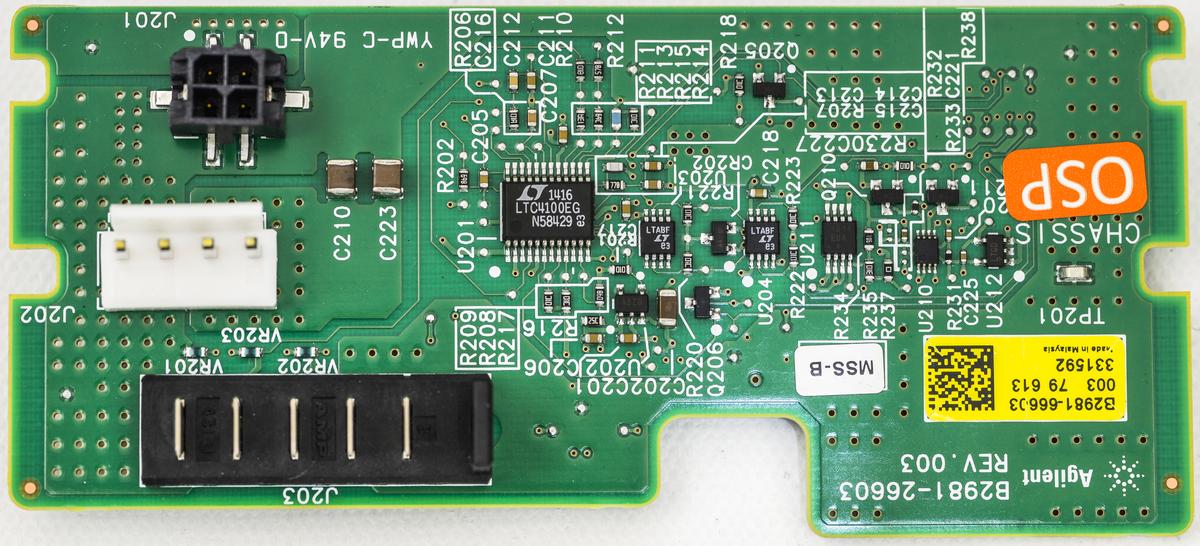
Board still have Agilent logo, and date code on Linear (today part of Analog Devices, sadly)
LTC4100EG charger controller reveals manufacturing period around week 16, year 2014.
LTC4100EG is the Smart Battery Charger Controller with digital SMBus telemetry support, wide 3.5 to 26V output voltage range and up to 4A of charging current capability. It is rather complex all in one chip with lot of functionality and protection available for safe charging and battery management.
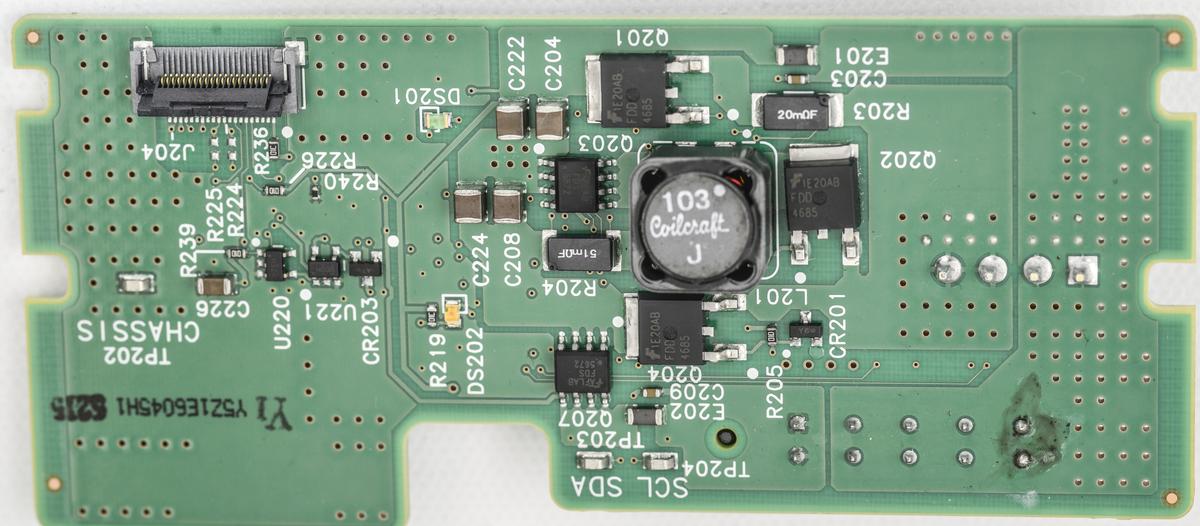
Rear side of the board also have components populated. These include pair of ON Semi FDS5672 60V N-channel MOSFETs, three ON Semi FDD4685 -40V P-channel MOSFETs, Coilcraft inductor, some 1210-sized MLCC(metal-layer ceramic capacitor)s and two shunts for current monitoring. There is tiny DS201 green LED for charge indication and couple of test points, marked SDA and SCL. These are obvious related to SMBus interface and available for easy probing.
Keysight does offer battery as an option N1418A, however
priced at $871 USD, that is almost five times over the original RRC2024 pack. Benchtop charger available from Keysight,
option N1419A goes at $1081 USD, clearly targeted for enterprise/business market customers.
Original battery from OEM manufacturer that Keysight use for B2987A is
Lithium-ion pack RRC2024. This battery have 6600 mAh capacity, rated for 14.4V and supports up to 4.6A charging current. It have internal cell 4-series 3-parallel (4s3p) topology. We have already ordered 3rd party battery to try in unit in standalone operation.
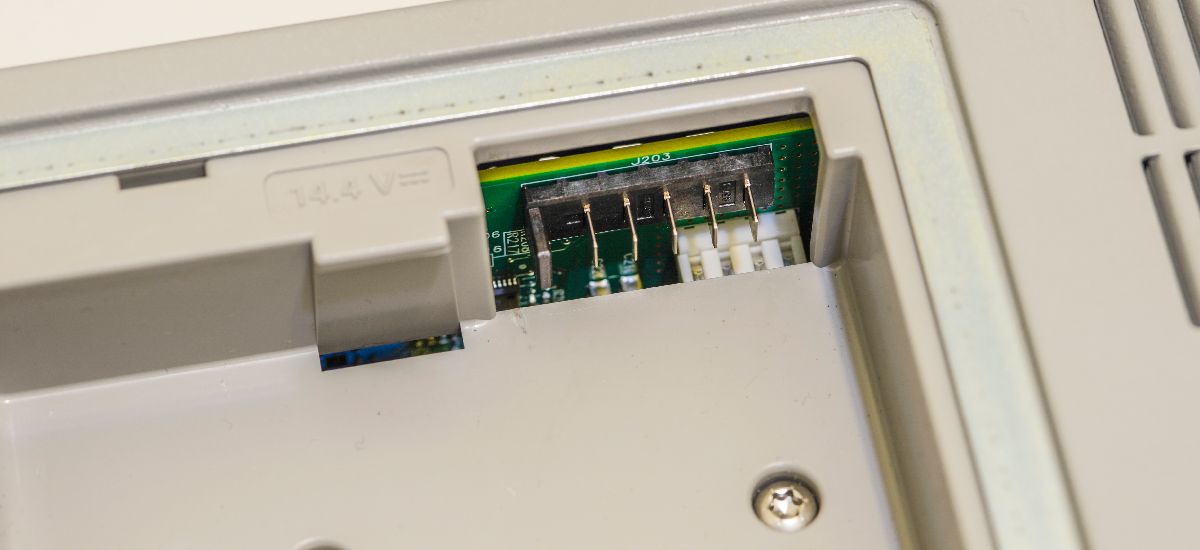
Battery and charger interface using blade-type connector, typical for power packs. There are five contacts to provide power and telemetry connection between the unit and the battery pack. According to the user's manual operation time on battery power for fully featured B2987A listed as mere 5 hours. Picoammeter B2983A without high-voltage source specified for 7 hours of battery life. This gives us some interesting math to guess. Meters power consumption = 95.0 WAh / 5 hours = 19 W. Two extra hours between the units means that high-voltage output option board takes about 5.4W of power alone. Would be interesting to know power savings possible if one would ditch power-hungry TFT front panel interface and its related FPGA logic? Hint to Keysight for NFP-version of the instrument for production test rigs

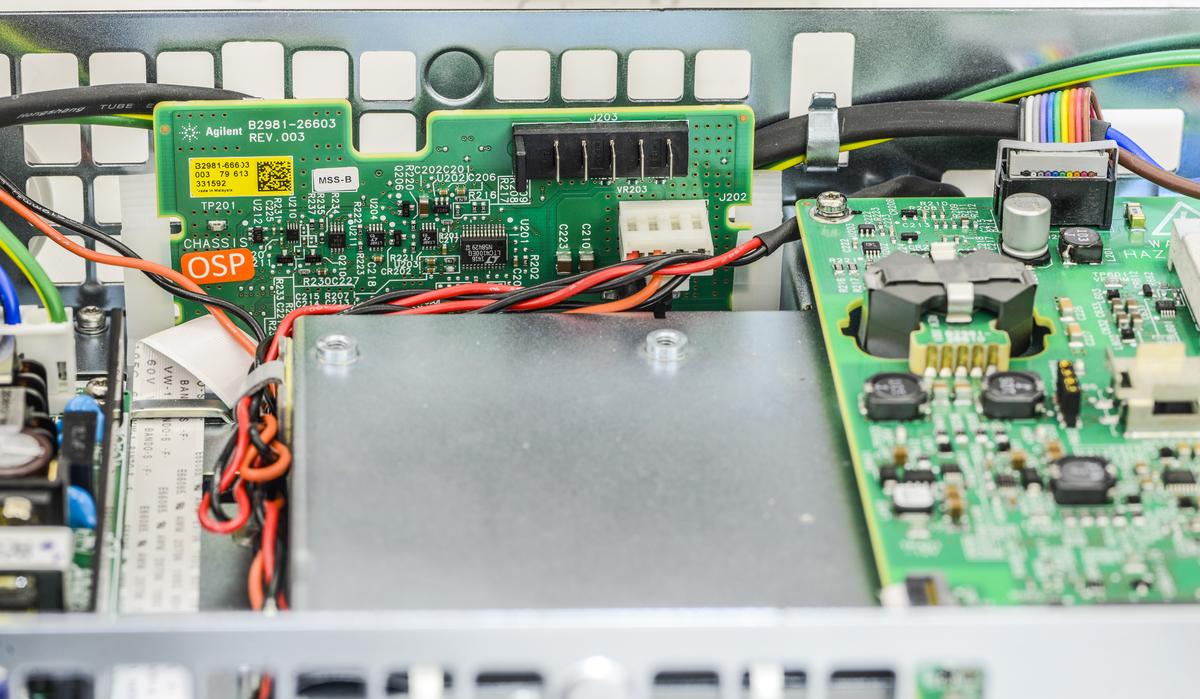
Interesting design note - charger board does not have rigid mount to the chassis and have small movement freedom. Two plastic holders keep the board in place, but allow flex to prevent contact damage and excessive stress during battery pack replacement/installation.
Main processor board / module P0500-63001Heart of the digital sub-system is
STMicro SPEAr eMPU (ARM Cortex-A9) with support of
Xilinx Spartan-3E FPGA. Xilinx FPGA provides acceleration and additional I/O for the SPEAr SOC to help interfacing all those peripherals onboard of B2987A.
Processor board is not unique design only for this instrument, but shared module design. It is also used in other Keysight instruments like B2900A series SMU, Agilent/Keysight 532xx series frequency counters, arbitrary signal generators. Some Keysight 1000X/2000X/3000 X-series oscilloscopes also share similar CPU topology.
Small investigation work revealed that Keysight B2987A running Windows Embedded CE 6.0. One hardware hacker even discovered how to run legendary
DOOM game on his Keysight DSOX1102G oscilloscope. Maybe next step is to try Quake on B2987A electrometer?

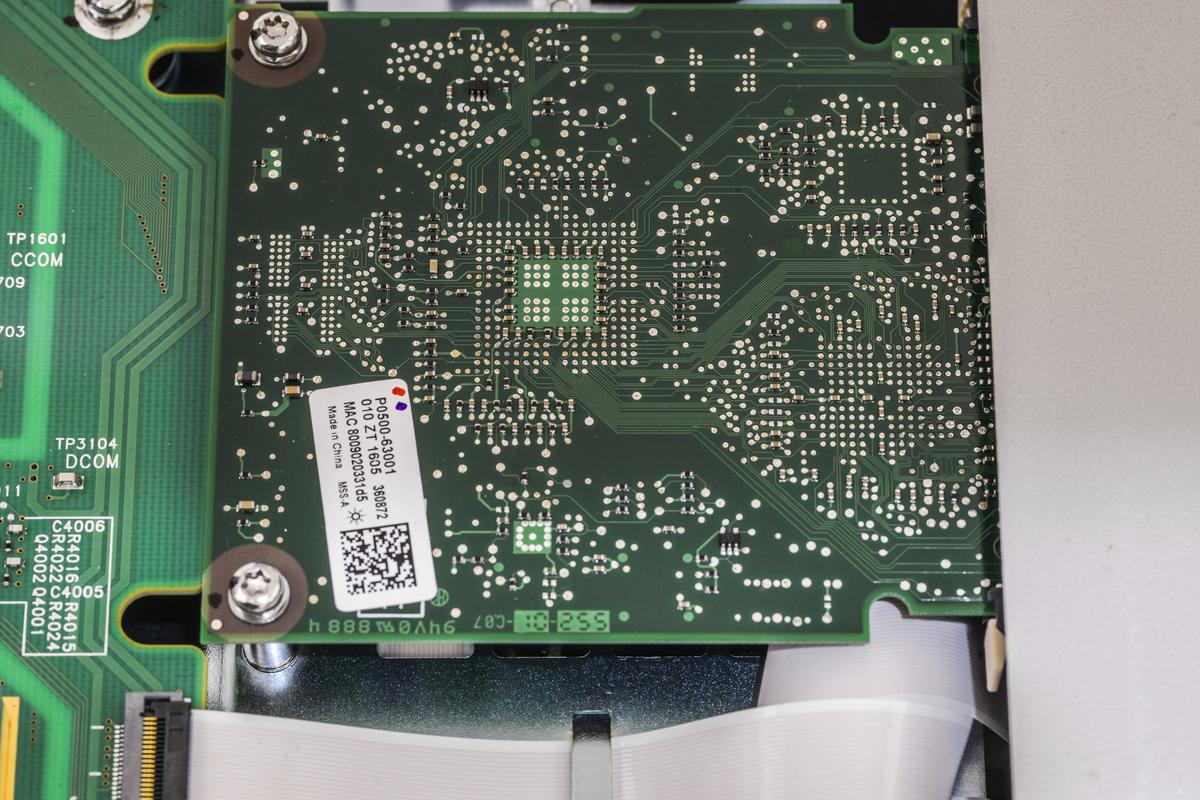
This board use mechanical SO-DIMM type slot to interface with front panel PCBA. This allows easy development and reuse of the existing design in various instruments and not uncommon concept in world of mixed-signal instrumentation. Board have metal U-shape plate glued to the processor (main BGA chip in center) to provide additional surface area for better thermal performance.

We can also find 63-VFBGA (9 x 11 mm) package with marking NQ432 is
Micron MT29F1G08ABADAH4-ITX:D NAND Memory with 1Gb (128M x

capacity and parallel interface. It stores OS and firmware code of the instrument. This NAND Flash is already EOL'd in February 2018 by the manufacturer, but reference price for it was about $3.5 USD a piece.
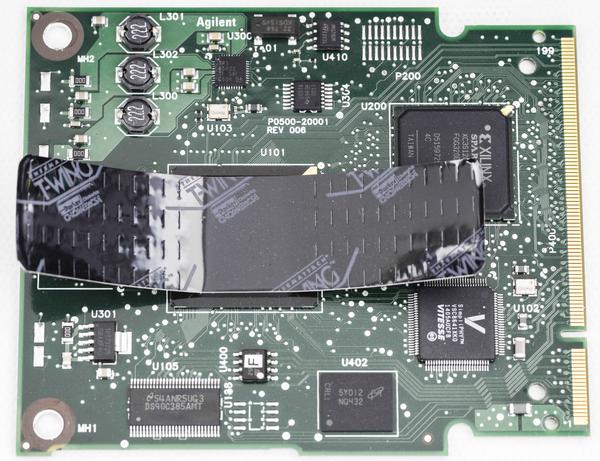
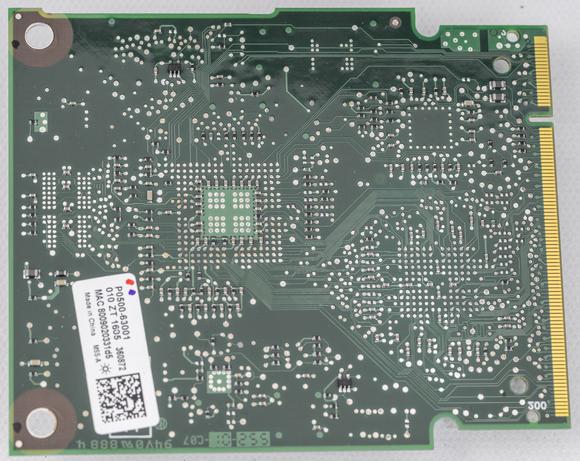 TI DS90C385AMT
TI DS90C385AMT in TSSOP package is programmable LVDS Transmitter, designed to convert parallel 24-bit RGB bus from SPEAr processor into serial
Flat Panel Display Link. This interface is quite similar to other modern display interfaces, but adapted for flat-panel interconnect.
Another Texas Instruments part - TPS73725 is 1 Amp LDO take care of memory bus termination voltage and related power delivery.
Vitesse VSC8641XKO is low-power 1GbE MAC+PHY interface chip that handle LAN/LXI connectivity of the instrument.
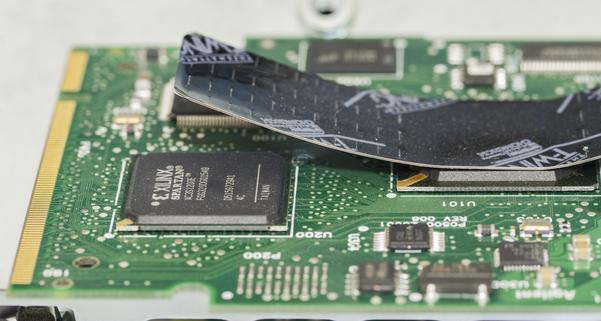
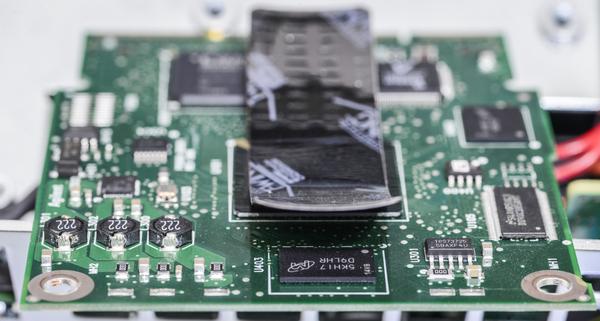
84-FBGA (8 x 12.5 mm) D9LHR hiding under the heatsink plate is
Micron MT47H64M16HR-3:H DDR2 SDRAM chip, also with 1Gbit capacity organized as 64M x 16 bit parallel bus. This lowest-grade 3ns RAM rated to run at 333 MHz (DDR-667 effective).
We can also find various support components, 32768 Hz XO for RTC timekeeping function and main power regulator, based around Texas Instruments TPS65023 PMIC. This regulator have three separate switching DC/DC regulators for SoC/FPGA power and three LDO regulators for auxilary power. There is even serial I2C interface for management and telemetry.
High-voltage output board B2981-66602 (only for B2985A and B2987A)This assembly generate programmable voltage output in either polarity with two available ranges. With only 1 W of available power it is not high power, but suitable for many biasing applications and test conditions.
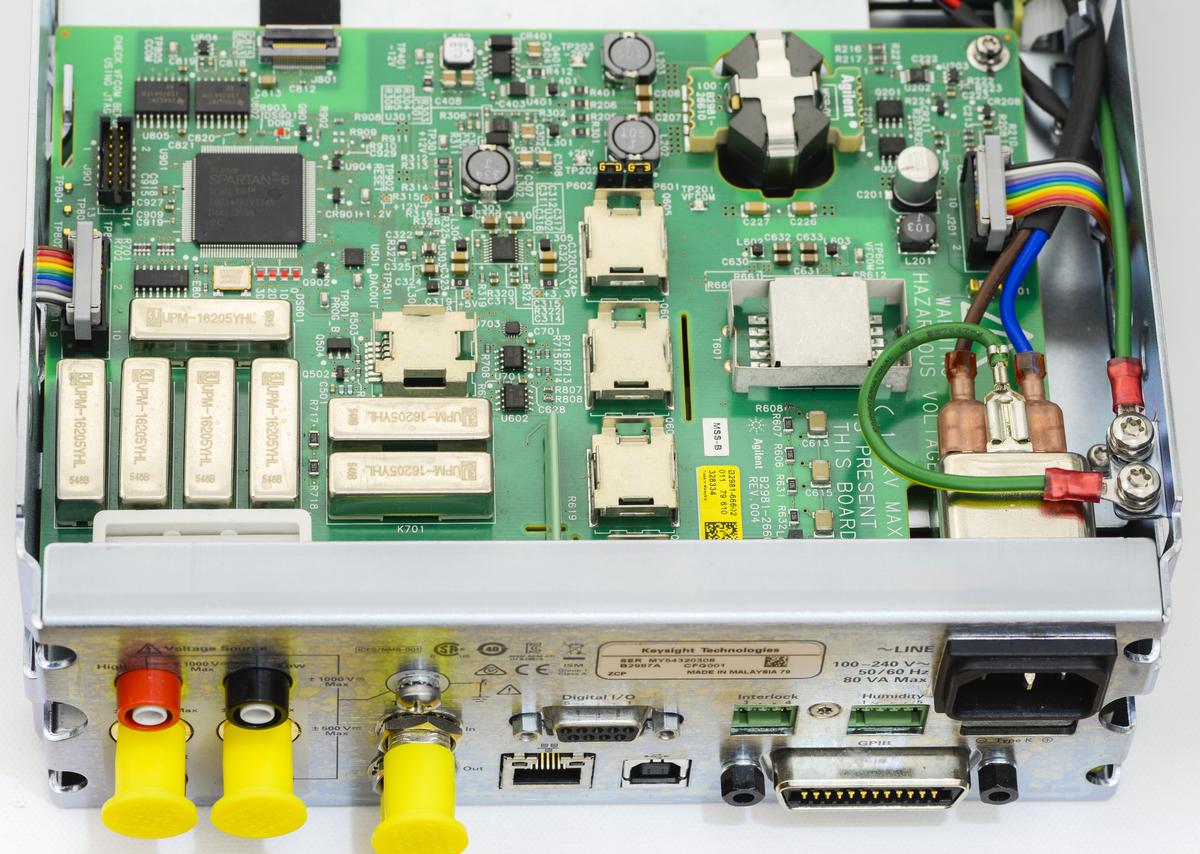
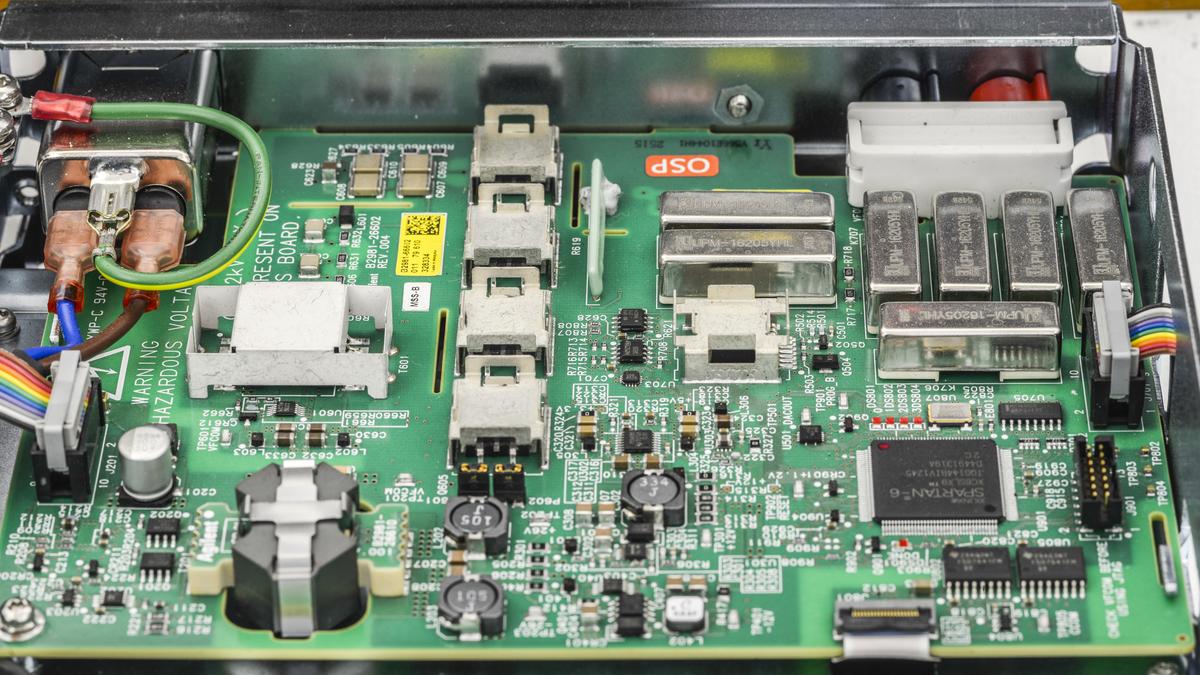
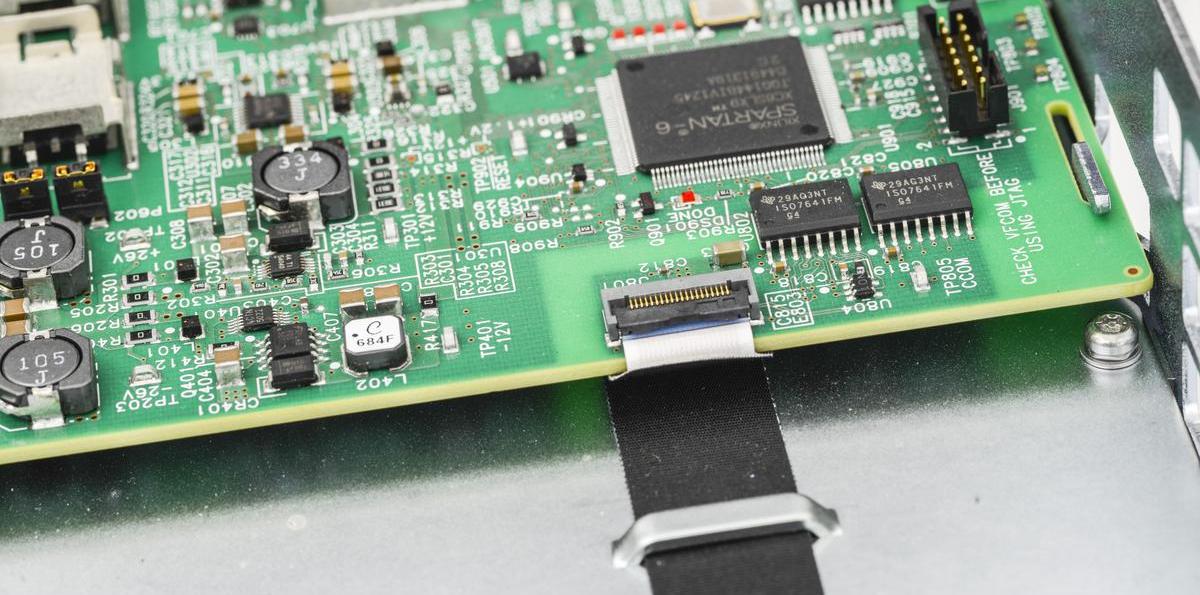
Interconnect for HV source is done via two 100 mil pitch 10 pin headers located on sides and going to main analog board. Digital control and programming performed thru FPC ribbon cable, close to digital isolators.
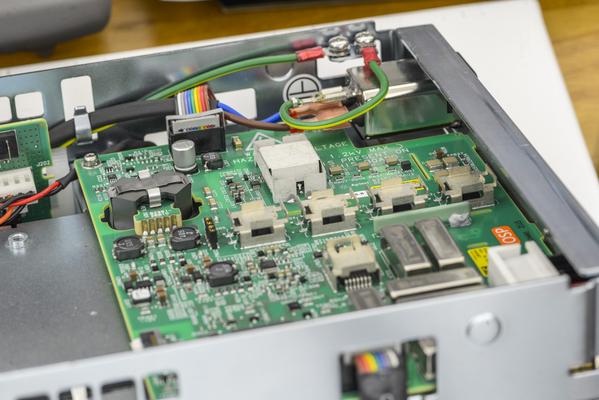
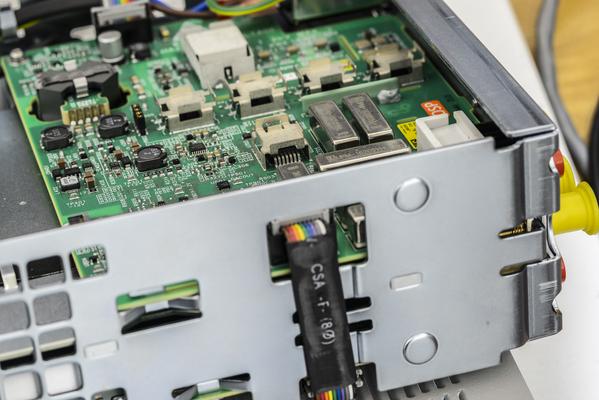
All active power devices have heatsinks mounted on them to help with thermal management. Unit does not have fan, so board location on top, right under the chassis vents definately helping here.
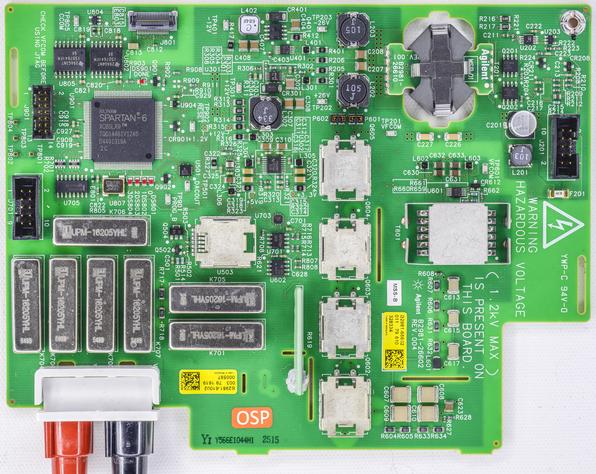
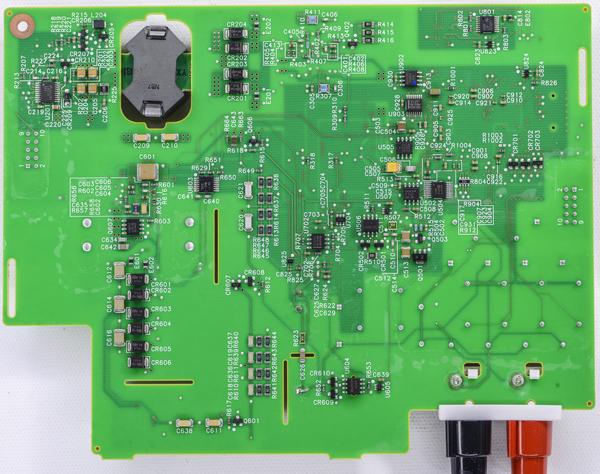
This PCBA is using 6 layers and have components populated on both sides. There are no special requirements for high leakage isolation so we don't see much guarding or slots here.
High voltage reed relays are manufactured by
TPM Sanyu Electric Model UPM-16205YHL designed for 1000V switching voltage and insulation resistance minimum 100 GOhm. Relay contacts rated to switch currents up to 1 A, way over the specification of the B2987A HV output. Relay activation coil voltage is 5V, and this type is non-latching.
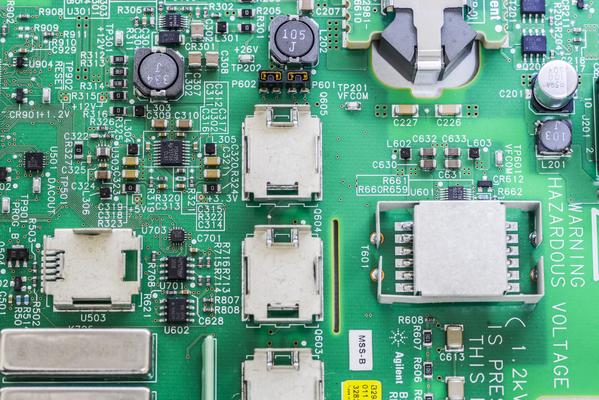
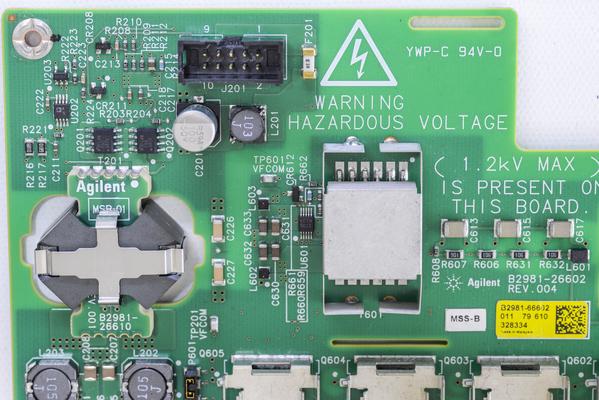
Galvanic isolation between high-voltage assembly and rest of the instrument provided by pair of Texas Instruments ISO7641FM 6kV[~pk~] low-power digital isolators. Each of these have four independent channels and rated for isolation at least 4200 VRMS. This is quite fast isolator with 7 ns typical propagation delay.
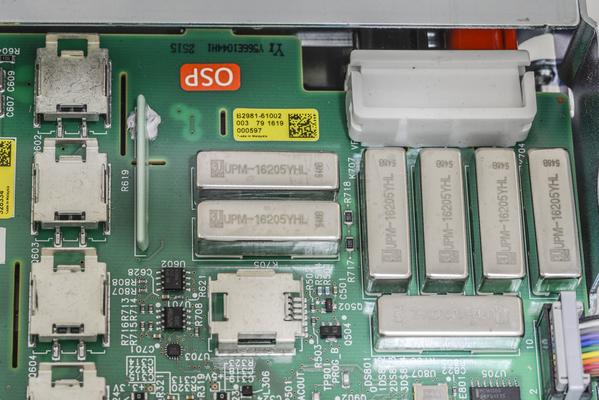
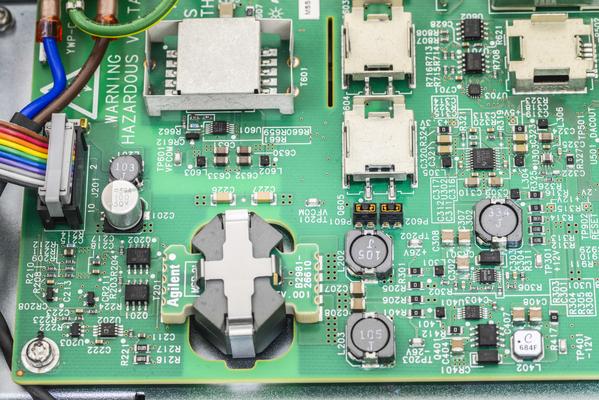
Pretty looking magnetic device is custom planar transformer. They got name from planar design made of metal windings etched in multilayer PCB and coupled magnetic core thru machined slots. This construction type of magnetics and conductors assembly have some clear advantages (and drawbacks too) over traditional wire-wound transformers. Advantages are compact footprint with low-height, low leakage inductance and excellent thermal characteristics. Drawbacks are capacitive coupling and more expensive manufacturing and design evaluation, however all these factors can vary a lot depending on application requirements and design.
This is still actively developed field as modern electronics demands even higher power density and better efficiency. There is
interesting PhD thesis paper by Ziwei Ouyang on these devices type. Worthy read if you into DC/DC converters and power conversion design.
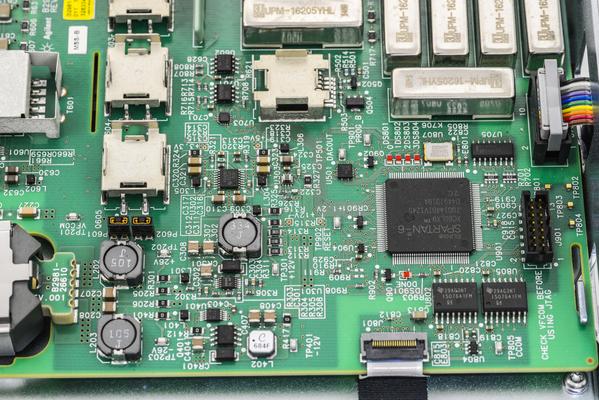
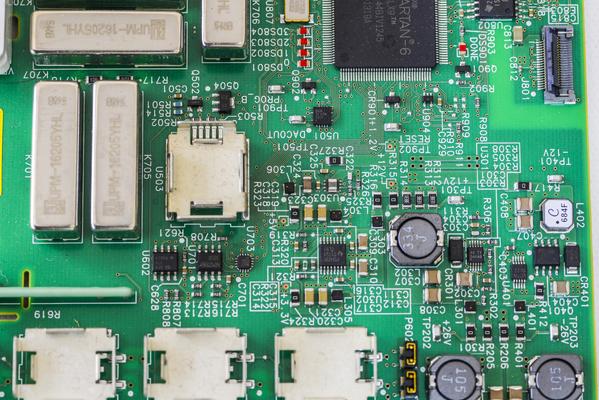
This board also have FPGA, Xilinx Spartan-6 LX, XC6SLX9. Used version have 9k logic elements, over 600 Kb of integrated memory, 16 DSP blocks and feature up to 102 configurable I/O pins in used TQFP-144 package.
Tiny QFN-14 chip near DACOUT as you may have guessed already is
Texas Instruments DAC8832 voltage programming DAC. This model is low-noise 16-bit voltage output single-channel DAC, operating from external reference. It have good INL (1 LSB) and fast settling time about 1 μs, which is important for fast response. It is connected directly to FPGA I/O for fast interfacing. Texas Instruments TPS54040 next to L304 33nH inductor is 42V 0.5A step-down buck regulator with adjustable switching frequency. Larger TSSOP package is another TI part - TPS54295. Another synchronous step-down buck switcher with intergrated FET and two output channels. Inductors next to this regulator are tiny, almost same size as 0805 passive component package, but wider. U303 catch the eye too, it looks like tiny 8-pin DFN package but with 0805-size capacitor on top. It has to be some local LDO regulator.